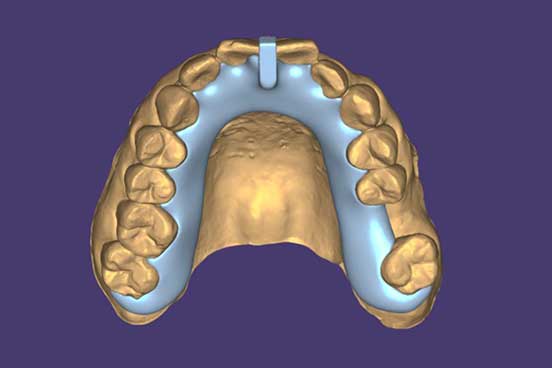Introduction
A Kois Deprogrammer is an occlusal appliance designed to help dentists and patients achieve a more stable and physiologic mandibular position. By temporarily disengaging the posterior dentition, it allows the jaw muscles to “reset” and find their true centric relation, improving comfort and providing invaluable diagnostic information for restorative treatment. At Smile Art Lab, the Kois Deprogrammer is an occlusal appliance designed to help dentists and patients achieve a more stable and physiologic mandibular position.
What Is a Kois Deprogrammer?
A Kois Deprogrammer is a removable, plastic device that covers the hard palate and creates a single point of contact between the lower central incisors and an anterior bite ramp. It functions as a separating appliance, allowing posterior teeth to disengage and removing occlusal interferences so that the mandible can reposition in Centric Relation the most anterior-superior position of the condyles in the fossa, considered the most reproducible and stable for restorative cases.
How It Works
By preventing tooth-to-tooth interlocking, the deprogrammer lets the masticatory muscles relax and erase longstanding engrams. Patients typically wear the appliance for one week to one month, depending on the severity of muscle memory and parafunctional habits, until they can consistently reproduce the same anterior contact point without guidance. During clinical verification, articulating paper confirms a reproducible point of contact on the ramp, indicating successful deprogramming.
Clinical Indications
Kois Deprogrammers are indicated for:
- Occlusal dysfunction and bruxism: Reducing muscle hyperactivity and night-time clenching.
- Facial pain or TMJ discomfort: Alleviating joint stress by guiding the mandible to its physiologic position.
- Tooth wear and restoration failure: Diagnosing and correcting destructive occlusal forces before further damage occurs. Kois Center
Benefits of a Kois Deprogrammer
- Streamlined diagnostics: Simplifies the evaluation of occlusion and path of closure.
- Patient comfort: Reduces facial pain, headaches, and muscle fatigue by allowing the jaw to relax.
- Protection of dentition: Minimises further wear, fractures, or loosening of teeth and restorations.
- Easy maintenance: The appliance can be cleaned with ordinary toothpaste and warm water during daily oral hygiene.
Taking Accurate Records: Impressions and Digital Scans
Analog Impressions
- Tray selection: Use a border-moulded, full-palate tray with adhesive for stable PVS
- Silicone vs alginate: Silicone offers high accuracy and can be stored or scanned; alginate is adequate if poured promptly and stored in a damp environment.
- Bite registration: Record the maxillomandibular relationship in maximum intercuspation using trimmed silicone to avoid “bounce.”
Digital Scans
- Full-arch coverage: Ensure clean palatal margins and minimal soft-tissue artefacts by retracting cheeks and lips.
- Bite scan: Capture both right and left sides in MIP with the patient seated at 45°; a leaf gauge can introduce a controlled posterior opening if required.
Lab Design and Fabrication Options
Retention and Coverage
- Palatal engagement: Frictional contact in slight undercuts secures the appliance; include an arch-wire or PMMA bow only if additional retention is needed.
- Ramp dimensions: Construct a 3–5 mm-wide anterior stop that discludes posterior teeth by 1–1.5 mm, adapting for Class II or III relationships.
Manufacturing Methods
- 3D printing: Cost-effective and efficient; accuracy depends on printer calibration and post-processing protocols.
- Milling: Utilises an acrylic puck for superior fit and durability, often at a higher fee but with predictable precision.
Fit and Finishing
- Undercut block-out: Minimise wax thickness to maximise retention undercuts while maintaining easy retrievability.
- Ramp angle: Align perpendicular to the long axis of the lower incisors (or the functional hinge-axis arc) to avoid unwanted tooth movement.
Why Choose Smile Art Lab for Your Kois Deprogrammer
At Smile Art Lab, we merge Kois Center’s evidence-based protocols with our state-of-the-art digital and analog workflow. Our Sydney-based laboratory ensures:
- Precision craftsmanship using both milled and printed techniques.
- Strict quality control, delivering appliances that meet Kois specifications.
- Timely turnaround and clear communication throughout every case.
Partner with Smile Art Lab for a Kois Deprogrammer that sets a new standard in occlusal diagnostics and patient comfort.
Conclusion:
Whether you’re managing complex occlusal cases or aiming to stabilise mandibular positioning, this device supports precision and predictability in treatment planning. At Smile Art Lab, we are committed to delivering Kois Deprogrammers that align with the highest clinical standards and your individual case requirements. With our advanced workflows, expert technicians, and unwavering attention to detail, your patients receive the quality and reliability they deserve. Contact us today to discuss your Kois Deprogrammer requirements.
FAQs
What is the purpose of a Kois Deprogrammer?
A Kois Deprogrammer helps relax jaw muscles and reposition the mandible into centric relation by disengaging the posterior teeth, aiding in diagnostics and treatment planning.
How long should a patient wear a Kois Deprogrammer?
Most patients wear the Kois Deprogrammer for 1 to 4 weeks, depending on muscle memory and parafunctional habits, until consistent jaw positioning is achieved.
Who is a good candidate for a Kois Deprogrammer?
Ideal candidates include patients with bruxism, TMJ discomfort, facial pain, occlusal dysfunction, or repeated restoration failure due to misaligned bite forces.
Can digital scans be used instead of traditional impressions?
Yes. Full-arch digital scans with clear palatal margins are acceptable alternatives, especially when combined with accurate bite records and minimal soft tissue artefacts.
Is a Kois Deprogrammer suitable for patients with Class II or III occlusion?
Yes. The ramp design can be adapted for various occlusal relationships to ensure effective deprogramming and posterior disclusion.
Why choose Smile Art Lab for Kois Deprogrammer fabrication?
Smile Art Lab combines Kois Center protocols with advanced digital and analog fabrication methods, delivering precise, comfortable, and clinically reliable appliances.

